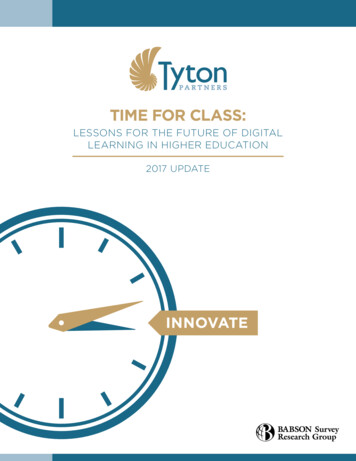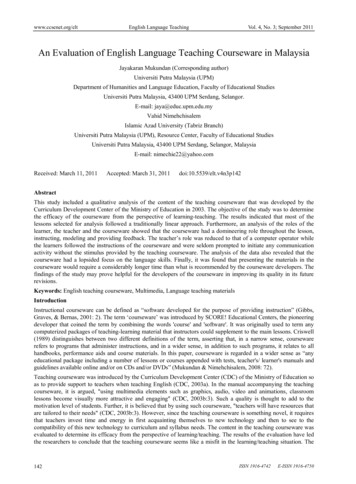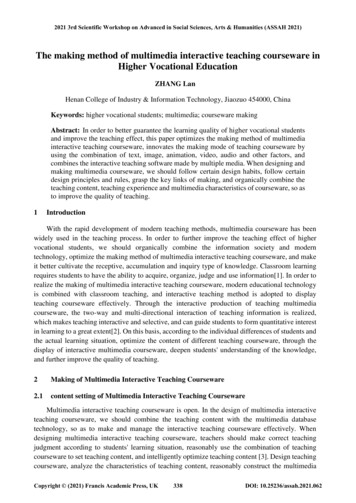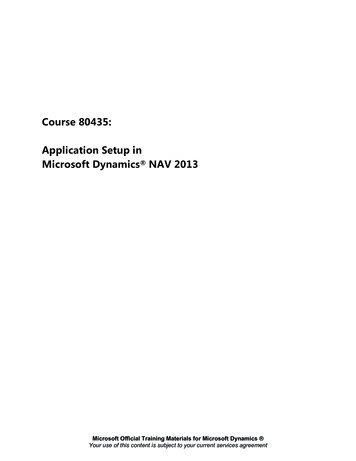
Transcription
TIME FOR CLASS:LESSONS FOR THE FUTURE OF DIGITALLEARNING IN HIGHER EDUCATION2017 UPDATEINNOVATE
TABLE OF CONTENTSINTRODUCTION.3EXECUTIVE SUMMARY.6BUILDING THE CASE FOR DIGITAL LEARNING.8THE STATE OF THE FIELD: FACING HEADWINDS. 12THE PLANNING AND EXECUTION OF DIGITAL LEARNING INITIATIVESIS FALLING SHORT OF “STRATEGIC” AT MANY INSTITUTIONS. 12FACULTY ARE A LINCHPIN IN DIGITAL LEARNING SUCCESS,YET THEY ARE WOEFULLY UNDERSUPPORTED. 14DIGITAL LEARNING DECISION-MAKING IS DECENTRALIZED. 17LOW COURSEWARE PRODUCT SATISFACTION INHIBITS LARGER-SCALE ADOPTION. 19NAVIGATING TOWARD DIGITAL LEARNING SUCCESS. 21INSTITUTIONS. 21VENDORS.23APPENDIX A: OVERVIEW OF SURVEY RESPONDENTS.25APPENDIX B: FIGURES REFERENCED IN PAPER.26APPENDIX C: COMPARISON OF 2014 AND 2016 FINDINGS.34ACKNOWLEDGEMENTS. 40BIOGRAPHIES. 41TIME FOR CLASS:2017 UPDATE2
INTRODUCTIONThe Time for Class series was first published in 2015 to share findingsfrom Tyton Partners’ 2014 surveys of over 2,700 postsecondary facultyand administrators on their use and perceptions of digital courseware.This paper is an update to the Time for Class series and includesfindings from two fall 2016 surveys of a national sample of 3,500postsecondary faculty and administrators. The purpose of this seriesis to illuminate the state of digital learning in higher education and toprovide recommendations to the field on opportunities to expand digitallearning in service of improved student outcomes.Since the initial surveys and research that contributed to the 2015 Time forClass publications, the dynamic digital learning and courseware productlandscape has continued its evolution. This evolution impacts not onlythe way instructional technology is used in teaching and learning butalso the lens through which we examine the market. Notable shifts in theproduct and distribution ecosystem include the following developments: The growing modularization of educational technology isexpanding options for digital learning delivery. The marketis shifting from one-size-fits-all “course-in-a-box” offerings toincreasingly flexible courseware options that enable course deliverythrough the thoughtful integration of different tools and platforms.Learning management systems are playing a larger role as coreinfrastructure for some courseware, and vendors are decidingwhether to replicate functionality or to design their products forintegration with existing tools already in use. Authoring and customization tools are increasingly enabling“personalized teaching” in digital environments. Going handin hand with the increased flexibility afforded by today’simplementation models, courseware vendors and digital learningplatforms are responding to customer demands by expandingauthoring toolsets to allow for increased customization of contentand the course experience. Open content is gaining share. Open educational resources arenow embedded in a range of platforms, including large-publisherand proprietary tools, making them easier to find and adopt. Thisshift is being fueled by the improved quality and availability ofopen content as well as the growing dialogue around the cost ofpostsecondary education and learning materials. The methods of accessing and disseminating digital content arediversifying and innovating. Content-agnostic delivery platformsare helping to level the distribution playing field for digital contentproviders by supporting discoverability, price transparency, anddelivery to buyers across institutions. At the same time, throughmembership in organizations like Unizin, institutions are able to gainbuying power and reduce the administrative lift of adopting newlearning technology, thereby lowering their switching costs andimproving their flexibility to adopt the solutions that best fit theirneeds at a given time.TIME FOR CLASS:2017 UPDATE3
The aperture of our research and analysis in 2016 also reflects anevolution since the first Time for Class publication. The core change is theexpansion of the scope of research from a focus on digital courseware –instructional technology solutions that enable digital learning – to digitallearning more broadly. A comparison of the 2014 and 2016 researchscope, objectives, and key definitions is provided below.20142016Scope ofStudyPostsecondary perspectiveson and adoption ofdigital courseware.Postsecondary implementationof digital learning, inclusive ofdigital courseware.ObjectivesTo better understand thecurrent level of adoptionof digital courseware in USpostsecondary education,as well as to collectpractitioner perspectiveson digital coursewareuse and barriers tofurther adoption.To better understandthe current degree ofimplementation of digitallearning, including keyorganizational factorsenabling digital learningimplementation, and theextent to which coursewarehas been adopted as part ofdigital learning strategies.KeyDefinitionsDigital courseware iscurriculum deliveredthrough purpose-builtsoftware to supportteaching and learning.Digital learning is the use ofinstructional technologies tosupport teaching and learning.Under this definition, digitallearning can take place inface-to-face, online, andblended/hybrid environments.Courseware is instructionalcontent that is scoped andsequenced to support deliveryof an entire course throughsoftware that is builtspecifically for educationalpurposes (e.g., YouTube isnot considered courseware).Courseware includesassessments to informpersonalization of instructionand is equipped for adoptionacross a range of institutionaltypes and learningenvironments (face-to-face,online, and blended/hybrid).Courseware is not a learningmanagement system.TIME FOR CLASS:2017 UPDATE4
Where possible in this paper, data points that are available from boththe 2014 and 2016 surveys are highlighted to demonstrate how facultyand administrator perspectives have changed or, in some cases, stayedthe same over that period. A complete set of charts comparing 2014 and2016 data is provided in Appendix C.In addition to data from the 2014 and 2016 Tyton Partners / BabsonSurvey Research Group surveys, this paper references data from theIntegrated Postsecondary Education Data System (IPEDS), includinginformation on distance education and institutional type. In this paper,distance education is defined as “education that uses one or moretechnologies to deliver instruction to students who are separated fromthe instructor and to support regular and substantive interaction betweenthe students and the instructor synchronously or asynchronously.” 1 Thetypes of institutions referenced include two-year institutions (public andprivate), four-year private institutions (non-profit and for-profit), andfour-year public institutions.The data on institutional type and the level of distance education offeredat the institutions represented by administrator and faculty respondentsto the 2016 surveys was used to classify respondents as belonging tothe following segments, referenced throughout this -YEAR,LOWDISTANCEPRIVATE4-YEAR,HIGHDISTANCE% ofAdministratorsin Sample6%15%20%19%33%6%% of Facultyin Sample10%24%20%24%19%3%Note: Institutions where the portion of undergraduate students taking at least one course at adistance is under 25% are considered low-distance, institutions where the portion is 25% or greaterare considered high-distance.This research was undertaken in partnership with the BabsonSurvey Research Group and with funding from the Bill & MelindaGates Foundation.1.Integrated Postsecondary Education Data System, “2016-17 Survey Materials: Glossary,” August orms/IPEDSGlossary.pdfTIME FOR CLASS:2017 UPDATE5
EXECUTIVE SUMMARYThe changing face of the US college student presents both new opportunities andnew challenges for higher education institutions and a system designed to serve thetraditional student of the past. Many institutions are under pressure to provide flexible,affordable, and workforce-relevant educational offerings, with scaffolding to enable allof today’s diverse learners to succeed, yet colleges and universities are constrained byregulatory and institutional structures that limit their ability to adapt to this new reality.Furthermore, the perceived and actual costs of change – in regard to finances, time,institutional culture, and reputation – are significant and together present a dauntingprice tag for an uncertain return in terms of student and institutional benefit.While a few dozen institutions have developed digital learning programs that have becomebeacons of success in the uncertain and often troubled waters of educational technologyadoption, evidence of the impacts of digital learning across the higher education marketmore broadly is limited, and many decision-makers remain skeptical. We believe thatquality digital learning programs can deliver flexible and personalized education thatmeets the needs of today’s learners and institutions, and this paper provides a few datapoints to help build the emerging case for expanded implementation of digital learning.Despite the potential benefits, faculty and administrators report that digital learninghas not been implemented consistently at their institutions, and several impedimentsstand in the way of scaled and effective implementation. From the survey responsesof 3,500 faculty and administrators, four market realities emerged that provide insightinto the issues slowing or halting scaled digital learning and limiting its benefits frombeing realized:1. The planning and execution of digital learning initiatives is fallingshort of “strategic” at many institutions. While institutions generallypresent their digital learning programs as being a strategic lever toachieve institutional goals, perceptions of the execution and impactsof digital learning vary significantly. This gap presents significantissues for digital learning success in terms of stakeholder buy-in andachieving and measuring impact.2. Faculty are a linchpin in digital learning success, yet they arewoefully undersupported. The majority of surveyed administratorsagreed that faculty are crucial to the success of digital learninginitiatives – serving as both a bolster and a barrier to implementationsuccess. Yet reports from both administrators and faculty suggestthat the resources to support faculty to implement digital learningare lacking.3. Digital learning decision-making is decentralized. Whenadministrators and faculty were asked about the influencers of twocritical decision points in digital learning implementation, it becameapparent that implementation at scale requires engagement withseveral decision-makers. While not without benefit, the decentralizeddecision-making structures in place at most institutions today generallyslow the adoption of teaching and learning technologies by increasingthe “cost of sale” for institutions and vendors.TIME FOR CLASS:2017 UPDATE6
4. Low courseware product satisfaction inhibits larger-scale adoption.Peer recommendations are the most frequently cited resource forproduct discovery among administrators surveyed in 2016. This impliesthat good products should gain adoption relatively easily throughword of mouth and that those products that miss the mark should notexpand in use. Unfortunately, faculty and administrator perspectives onthe digital courseware products in use at their institutions today reflectdissatisfaction and an unwillingness to recommend to peers.Opportunities exist for all stakeholders in the postsecondary ecosystem to dismantlethe impediments to broader, more effective digital learning adoption and its impactson student and institutional success. This paper helps to build a case for expandeddigital learning and delves into the four market realities, described above, that todayslow or prevent scaled implementation. It also provides recommendations for threetypes of stakeholders – institutions, vendors, and partners – to work toward building theconditions for digital learning success.TIME FOR CLASS:2017 UPDATE7
BUILDING THE CASE FOR DIGITAL LEARNINGDespite the efforts of vendors, researchers, and many institutions, the evidencearticulating the benefits of digital learning is generally considered incomplete, and thislack of broadly available and applicable evidence has implications. One implication isthat many decision-makers remain skeptical of the value that digital learning can deliverin higher education, though perceptions have improved since 2014. Another, potentiallyrelated, implication is that many institutions are slow to implement and scale digitallearning initiatives. Some instead undertake repeated, small-scale pilots and evaluationsto establish their own evidence for expanding adoption. Others dabble in digital learningto test the waters, implementing without specific goals or alignment to a strategic vision.In classic chicken-and-egg fashion, the result is that many implementations remainincomplete, lacking the stakeholder alignment and investment in support resources andpractice change that would enable successful and impactful implementations.FIGAPROGRESS TOWARD DIGITAL LEARNING IMPLEMENTATION RELATIVETO STRATEGIC PLAN %21%23%MIDPOINT22%20%19%0%8%2-YEAR,LOW DISTANCE2-YEAR,HIGH DISTANCE24%16%11%PUBLIC 4-YEAR,LOW DISTANCE21%4%PUBLIC 4-YEAR,HIGH DISTANCE25%11%PRIVATE 4-YEAR,LOW DISTANCEPRIVATE 4-YEAR,HIGH DISTANCEAdministrator Survey Question: How far along is your institution toward implementing digital learning in relation to its strategicplan? (On a scale of 0-100%)In 2014, 20% of faculty respondents reported being “skeptical aboutthe efficacy of digital courseware,” and another 28% were neutralabout its potential for impact. In 2016, 16% of faculty reported beingskeptical, and 21% were neutral on courseware’s potential for impact.Though progress has been made toward converting skeptics andnon-believers, this gap must be closed before key decision-makersare consistently confident in courseware’s potential to improvestudent outcomes.(Appendix B, Figure 1)TIME FOR CLASS:2017 UPDATE8
Uncertainty about the impacts of digital learning extend to itsfinancial impacts. In 2014, only 23% of administrators and 27% offaculty agreed that courseware “reduces the cost of instruction.”In 2016, 53% of administrators reported that digital learninghad been implemented in pursuit of more cost-effective coursedevelopment and delivery, and 61% reported that digital learninghad been implemented to help identify new or alternative revenuestreams for their institution. Among those administrators, less thanhalf of each group reported that the impact of their digital learningimplementation has met or exceeded their expectations in eitherof those areas.Fortunately, a case for digital learning is being built, piece by piece, as institutionsshare stories of their successes, as researchers publish their analyses, and as individualeducators see the impacts of digital learning on their learners and programs. In thissection, we seek to contribute to the growing evidence base by sharing a handful of datapoints that demonstrate where digital learning is having a positive impact in support ofselect institutional goals.One area where administrators report seeing the impact of digital learning is in improvedaccess and scheduling flexibility for students. 72% of administrators responding tothe 2016 survey selected “improve access and scheduling flexibility for students” asa strategic priority that is being supported by digital learning at their institution. Ofthose, 65% reported that the impact of digital learning in this area was meeting orexceeding their expectations, while another 10% said it is too early to tell. The impactswere particularly strongly felt at two-year institutions, where 75% of administrators whoindicated that digital learning had been implemented in support of improved accessand flexibility reported impacts that met or exceeded their expectations. Improvedscheduling flexibility and access has meaningful potential to support improved studentand institutional success by providing greater potential for learners to take the coursesthat they need when they need them. This is particularly important to support completionby the over 70% of college students who work while enrolled and the 19% of thoseworking learners who are balancing school, jobs, and children. 2Additionally, 69% of administrators surveyed indicated that digital learning had beenimplemented at their institutions in pursuit of the goal of encouraging faculty to implementinnovative instructional methods. Of those, 59% reported that the progress toward goalsin that area met or exceeded their expectations, and again, the impacts were felt moststrongly at two-year institutions. While encouraging innovation in instruction does notnecessarily result in better outcomes for students or institutions, the progress reportedtoward goals in this area is another indication of the potential positive impacts of digitallearning implementation.In addition to the survey data, analysis of IPEDS data on US degree-granting institutions,though imperfect, is valuable to help identify impacts and trends in digital learning thatmay not be perceived at the individual or institutional level. Using the most recent dataavailable on distance learning, institutional spending, and completion, we found that2. Anthony P. Carnevale, Nicole Smith, Michelle Melton, and Eric W. Price, “Learning While Earning: The New Normal,” GeorgetownCenter on Education and the Workforce, 2015, nersTIME FOR CLASS:2017 UPDATE9
institutions where a greater proportion of undergraduate students take at least onecourse at a distance spend less on instruction and student support and at the sametime show comparable or greater completion rates relative to institutions with a lowerproportion of distance learners. 3 Though distance learning is not the same as digitallearning, we believe that looking at the percentage of students taking at least one courseat a distance provides a valuable proxy for the scale of digital learning implementationat an institution. The takeaway from this analysis is that greater scale in digital learning isassociated with lower costs and consistent or improved rates of completion, as measuredby IPEDS data across US institutions.AVERAGE INSTRUCTION AND STUDENT SERVICESSPENDING PER COMPLETION; AND AVERAGE COMPLETIONSPER 100 FTES, BY INSTITUTION SIZE AND PERCENTTAKING COURSES AT A DISTANCE (UNDERGRADUATE)FIGBSPEND PERCOMPLETION 110K 100K 50K21222120 82K18191721211817192020201918 91K2020 70K 60K 101K2222 90K 80KCompletionsper 100 FTE 105K19 75K17 66K 61K 59K 52K 49K 43K 42K 40K 40K 35K 43K 36K 34K 53K 51K 51K 49K 35K 30K 30K 20K 10K 0KINSTITUTION SIZEne 0% 5% 0% % No 1-1 10-2 5-4 402 %%%**ne 1-10 -25 -40 40%No10 25 %%%**ne 1-10 -25 -40 40%No10 25 %%%**ne 1-10 -25 -40 40%No10 251.5K-5K FTES5K-10K FTES10K-20K FTES20K FTESlne 0% 5% 0% % otaTNo 1-1 10-2 5-4 402Percent of undergraduatestudents taking at least onecourse at a distanceALL INSTITUTIONSINSTRUCTION & STUDENT SERVICES SPEND PER COMPLETION** Completions included in analysis are associates degrees, bachelors degrees, and certificates of at least one year** Excluded, low nSources: Babson Survey Research Group, IPEDS, Tyton Partners analysis3. Analysis includes degree-granting institutions with at least 1,500 undergraduate full-time enrollment equivalents as of fall 2014and includes the following IPEDS and calculated variables: completions; instructional and student support costs; and FTEs(estimated undergraduate full-time enrollment equivalents) for fall 2014.TIME FOR CLASS:2017 UPDATE10
IPEDS data on enrollment also shows that distance learning growth outpaced enrollmentgrowth overall from 2012 to 2014. This data is particularly relevant for institutions thathave enrollment or revenue growth goals and are considering starting or expandingdigital learning programs.FIGCUNDERGRADUATE DISTANCE LEARNING OVER TIMEEnrollment in at least 1distance course2%1.4M7%16%1.2M1.0M0.8M1.37M1.33M MCAGR* TotalUndergraduateEnrollment0.53M 0.52M0.92M0.49M0.49M0.43M 0.43M4%0.12M 0.12M 0.13M2-YEAR,LOW DISTANCE2-YEAR,HIGH DISTANCEPUBLIC 4-YEAR,LOW DISTANCEPUBLIC 4-YEAR,HIGH DISTANCEPRIVATE 4-YEAR,LOW DISTANCEPRIVATE 4-YEAR,HIGH rces: IPEDS, Tyton Partners analysis* CAGR stands for compound annual growth rateWhile work remains to further validate the impacts of digital learning, the case for digitallearning is beginning to be built, and its potential benefits should not be ignored.In summary, scaling digital learning enables institutions to accomplish the following:1. Improved access and scheduling flexibility, benefiting studentswho are older and working while in school in particular.2. Faculty engagement and experimentation with innovativeteaching practices.3. Higher rates of degree completion at lower instructional costs.4. Enrollment growth at a time when the market overall is flator declining.TIME FOR CLASS:2017 UPDATE11
THE STATE OF THE FIELD: FACING HEADWINDSEnabling effective digital learning and the benefits it can deliver requires understandingthe impediments that stand in its way today. The 2016 administrator and faculty surveysincluded questions on organizational factors influencing digital learning implementation,extent of use, the goals for digital learning, and barriers that stand in the way of success.Through the surveys, we also sought to collect faculty and administrator attitudes towarddigital learning and perspectives on digital learning products, including courseware.Through analysis of the survey data, four institutional and market realities emerged thatshine light on the issues hindering effective implementation of digital learning at manyinstitutions today.THE PLANNING AND EXECUTION OF DIGITAL LEARNING INITIATIVESIS FALLING SHORT OF “STRATEGIC” AT MANY INSTITUTIONSStrong strategic vision and execution is crucial to the success of potentially transformativedigital learning initiatives at a postsecondary institution. At first glance, it appears thatmost institutions are thinking and acting strategically with regard to digital learning: themajority of administrators across institutional segments reported that digital learning isincluded in their institution’s strategic plan, and 25% said that it is a core component ofthe plan. Furthermore, digital learning initiatives are being implemented in pursuit of arange of strategic priorities, including institutional and student-focused goals. (AppendixB, Figures 2, 3, and 4). When asked whether their institution’s digital learning initiativeswere implemented in support of any of seven strategic priorities, administrators onaverage indicated that digital learning at their institution was implemented in pursuit ofthree or four of the priorities listed.FIGDEXTENT OF DIGITAL LEARNING IMPLEMENTATION IN SUPPORTOF INSTITUTIONAL STRATEGIC PRIORITIES (ADMINISTRATOR)0%10%20%30%Improve accessand schedulingflexibility for students50%60%70%80%72%Encourage faculty toimplement innovativeinstructional methods69%Identify new / alternativerevenue streams61%Become more costeffective in coursedevelopment and delivery53%Increase retentionand rates of degreecompletion52%Enhance the value ofour institutional brandIncrease the diversityof the student body40%26%33%Digital learning has been /is being implemented in pursuitof this strategic %47%29%90%41%55%Digital learning is not integralto this strategic priority9%11%16%1,1291,1271,123Not a strategic priority / NAAdministrator Survey Question: Is the use of digital learning at your institution important to helping achieve any of thefollowing strategic priorities?TIME FOR CLASS:2017 UPDATE12
Better articulation of how digital learning supports institutional goalsimproves perceived success, according to administrator responses;the greater the number of strategic priorities that an administratorindicated are supported by their institution’s digital learning initiatives,the more ideal they perceived the digital learning environment to beat their institution. (Appendix B, Figure 5)And yet, though two-thirds of administrators agreed that digital learning is viewed asa strategic lever to achieve institutional goals, the perceived impacts of digital learninginitiatives on strategic priorities are quite mixed. Particularly in areas like cost reductionand revenue generation, many administrators reported that digital learning has not mettheir expectations for impact.FIGEPROGRESS TOWARD GOALS AS A RESULT OF DIGITALLEARNING IMPLEMENTATION (ADMINISTRATOR)0%10%20%30%Improve access andscheduling flexibilityfor students40%50%60%70%65%Encourage faculty toimplement Innovativeinstructional methods31%38%Become morecost effective incourse developmentand delivery38%Enhance the value ofour institutional brand50%Increase the diversityof the student body43%PROGRESS AT OR ABOVE ease retentionand rates ofdegree completion90%25%59%Identify new / alternativerevenue streams80%31%25%33%BELOW EXPECTATIONSOR NO PROGRESS67858658125%52824%316TOO EARLY TO TELLNote: Respondents for each strategic priority above include only those who indicated that digital learning has been / is beingimplemented in pursuit of this strategic priority in a prior questionAdministrator survey question: has your institution demonstrated progress toward its goals In your strategic priority area as aresult of implementing digital learning technology?Compared to the IPEDS data analysis suggesting that higher levels of distance educationare associated with lower instructional delivery costs 4 and equal or improved rates ofcompletion, administrator responses suggest a disconnect between the impacts thatmany administrators perceive and the reality of how digital learning is changing themarket. Open-ended responses from administrators and faculty provide greater insightinto this disconnect, highlighting a few likely causes: Expectations for digital learning impacts are set too high Sufficient resources are not being allocated to support strategy execution The impacts of digital learning initiatives are not beingmeasured or communicated well4. Instructional delivery costs represent two IPEDS spending categories—instructional support and student support—and arecalculated per undergraduate credential granted (bachelor’s degree, associate degree, and certificates of one year or more).TIME FOR CLASS:2017 UPDATE13
“My experience across two institutions with digital learning is that there issubstantial expectation for its use with very little real support, and absolutelyno extra time allotted for faculty to learn, develop, and become comfortablewith this modality. It is all very much up to the individual faculty member tofigure that out, figure out whom to ask for help, and find the time to do so. Ihave found this difficult and quite stressful, especially in the first few runs ofan online course, where significantly more time is required for development,but this is not accounted for in any ways by which faculty are assessed. I alsothink there is lots of misunderstanding on the part of administrators (associatedeans, deans, and higher) about what good digital learning takes. More thanonce I have been told that I didn’t need more time to implement a change toa more digital learning course because ‘you just put the materials there and itruns itself.’ Anyone who has done any reading at all on digital learning knowsthis is not the case, and yet these same people are often the ones making thedecisions about digital learning.”– Full-Time Faculty Member“We do not have a center for teaching and learning, although there was sometalk of starting one. Without real support for learning and measuring theusefulness of new pedagogies, faculty cannot be expected to make headwayin successfully integrating technology in their courses. Some individual facultymembers really like technology and end up as standouts in its use, but theuniversity has a tendency to promote the achievements of this small groupand to ignore the fact that there is no systematic support for transforming toeffective digital pedagogies.”– Department Chair, Four-Year Public High-Distance Institution“Fully online is what
and administrators on their use and perceptions of digital courseware. This paper is an update to the series and includes Time for Class findings from two fall 2016 surveys of a national sample of 3,500 postsecondary faculty and administrators. The purpose of this series is to illuminate the state of digital learning in higher education and to











